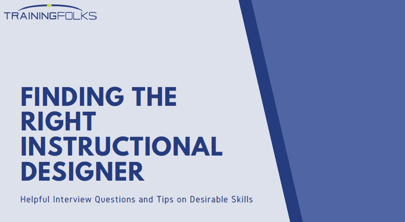When Do I Need an Instructional Designer's Skill Sets?
Instructional Design is the art of creating an environment and materials that create a learning environment designed to successfully facilitate your learning outcomes.
An Instructional Designer's skill sets are critical to building impactful training programs. The role of an Instructional Designer is to identify any skill or knowledge gaps of a target audience and to design learning that fills those gaps. They are tasked with conducting a learning needs analysis and developing training materials to support and drive improved performance, such as eLearning, teaching manuals and student guides.

How can you tell if you need the help of an Instructional Designer?
Here are a few signs that you might benefit from their help.
- Your Employees Underperform After Training
After implementing training, the last thing you want to see is employees that haven’t learned or are still struggling. Have your training efforts had little or no impact? This is where an Instructional Designer can help.
Many times, corporate training can feel very content-focused rather than employee focused. A good Instructional Designer takes the time to understand the learners and their challenges and can improve employee engagement with well-planned and thought-out learning materials that align with your training goals. Your employees are likely going into the training with the mindset that they want to improve their knowledge or skills, but training that falls short or doesn’t pinpoint their needs won’t help.
A good Instructional Designer will also make sure to include real-life scenarios that the learners can relate to. This will include familiar language, examples, imagery and context. They will make sure that the course is tailored to your learners’ needs and your employees will benefit by getting a well thought out and cohesive learning experience.
- Your Training Modules Are Inconsistent
There are many different formats that you can use for your training, whether eLearning, classroom-based, virtual instructor-led training, or video training. Part of an Instructional Designer’s role is to help figure out what modality would be best, based on the subject as well as the target audience. Once a modality is decided upon, the Instructional Designer has the knowledge and tools to design content that is cohesive. Training materials or courses that are inconsistent can be a huge factor in determining whether or not your employees will find success in the training.
A few of the areas that Instructional Designers focus on when designing training includes creating a style guide, reducing cognitive load, and making sure it’s intuitive. They will make sure your training programs all follow a similar format and structure without becoming repetitive while ensuring all methods align to deliver a consistent message. Designing training this way prevents employees from losing track of their progress or becoming confused. They will understand where they're going, and they'll perform much better.
- Your Business Is Losing Money and Getting Complaints
If you have noticed that you’ve been getting increased customer complaints or sales are dropping, this could be another sign that you should consider hiring an Instructional Designer. Your employees may have undergone training that was poorly designed, thus setting them up for failure.
An Instructional Designer's skill sets would be able to identify any gaps and improve your employees’ performance by tailoring training content that can benefit them, allowing your employees to master their roles a lot faster.
Customers are the heart of any business, so learning how to properly interact with customers is an important part of any well-designed training program. By creating a better experience, customers will enjoy doing business with you, in turn increasing company revenue.
- Your Employees Don't Enjoy Your Training
When employees don't enjoy training, they become unengaged, bored and they're not going to learn much from it. Typically, they'll halfheartedly progress through the course to meet your expectations.
You’ll likely notice they're not gaining much from their training nor are they looking for ways to implement it in their role.
The goal should be to create training that is fun and motivating. The training should always be for the benefit of the learners. An Instructional Designer gets to know your learners and makes sure to incorporate elements into the training that can improve your employees' engagement with the material. The more engaged they are, the more they'll gain from the training!
- Your Employees Aren't Passing Their Training Assessments or Passing Too Easily!
Have your employees been failing their assessments, or completing them so quickly as if they aren’t challenging enough? This should be a red flag that something is wrong. More than likely, they're failing because the modules aren't effective, are too complicated, or the training has been designed in such a way that the information presented is too easy and nothing new has been learned. If they are passing too easily, it could mean the material isn’t challenging enough – or you have a team of superstars! Adding an Instructional Designer's skill sets to your team will ensure that the training is at the right level of difficulty and that your employees are coming back with key takeaways.
Ready to work with an Instructional Designer but not sure where to begin?
Get our FREE eBook Download: 'Finding the Right Instructional Designer'


